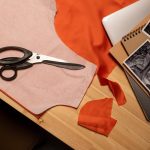Yes, suede fabric does fray when you cut it if you’re not careful. Its soft, fibrous texture means edges can unravel easily without sharp tools and smooth cuts. You’ll want to use precise scissors and consider sealing edges with special glue or stitching to keep them neat. Proper care after cutting also helps maintain suede’s velvety look. If you want to handle suede like a pro, there’s more to know about cutting and caring for it.
Table of Contents
Key Takeaways
- Suede fabric can fray when cut due to its soft, fibrous nap and lack of a protective outer layer.
- Using sharp, clean blades and smooth cutting motions minimizes fraying on suede edges.
- Without edge sealing or stitching, cut suede edges are vulnerable to unraveling and loose fibers.
- Applying fabric glue, fray check, or binding edges helps lock fibers and prevent fraying.
- Improper cutting tools or techniques, like dull scissors or cutting against the grain, increase suede fraying risk.
Understanding the Structure of Suede Fabric
Suede fabric comes from the underside of animal hides, usually from lamb, goat, or calf. When you look closely, you’ll notice its soft, napped surface, created by buffing the inner layer of the hide.
This process gives suede its characteristic velvety texture, making it distinct from full-grain leather, which uses the outer skin. Because it’s made from the hide’s flesh side, suede lacks the protective outer layer, which makes it more flexible but also more delicate.
When you handle suede, you’ll feel its unique softness and slight fuzziness, but you should also be aware that its fibrous structure can be prone to damage. Understanding this helps you appreciate why suede needs careful handling to maintain its appearance and durability over time.
How Cutting Affects Suede Edges
When you cut into this delicate fabric, the edges can quickly start to fray if not handled properly. Suede’s soft nap and fibrous texture make the cut edges vulnerable to unraveling, especially if you use dull scissors or jagged cuts.
To minimize fraying, make certain you use sharp, clean blades and cut in a single, smooth motion. Avoid tugging or stretching the fabric while cutting, as this can loosen fibers and cause more fraying.
After cutting, you might notice some loose fibers along the edges; don’t worry, trimming these carefully will help keep the edges neat. Taking these steps guarantees your suede maintains a clean finish and lasts longer without unsightly fraying.
Comparing Suede to Other Fabrics in Terms of Fraying
Although many fabrics fray to some extent, suede behaves differently due to its unique texture and construction. When you cut cotton or linen, loose threads often unravel, creating visible fraying along the edges.
In contrast, suede is made from the underside of animal hide, giving it a dense, napped surface that resists this unraveling. Unlike woven fabrics, suede’s fibers are more compact and less prone to coming apart at the edges.
However, it can still develop a rough or fuzzy edge rather than traditional fraying. If you’ve worked with synthetic or silk fabrics, you know they fray easily because of their looser weave and smooth fibers.
Suede’s structure means you won’t see the same thread-by-thread unraveling, but you should still handle cut edges carefully to maintain its appearance.
Techniques to Prevent Fraying on Suede
To keep your suede from fraying, you’ll want to focus on edge sealing methods and using the right cutting tools.
Sealing the edges helps lock the fibers in place, while sharp, precise tools prevent unnecessary damage.
Let’s explore how these techniques can extend the life of your suede projects.
Edge Sealing Methods
Since suede tends to fray easily along its edges, you’ll want to apply effective sealing methods to maintain its appearance and durability.
One common approach is using fabric glue or fray check along the cut edges; these products bond the fibers, preventing them from unraveling.
Another method involves sewing a tight stitch, like a zigzag or overlock, close to the edge to lock the fibers in place.
If you prefer a no-sew option, applying a thin layer of clear nail polish can also seal edges temporarily, though it may stiffen the suede.
Finally, binding the edges with leather or fabric trim not only stops fraying but adds a polished finish.
Proper Cutting Tools
Choosing the right cutting tools plays an essential role in preventing suede from fraying. You’ll want to use sharp, fine scissors or a rotary cutter to make clean, precise cuts. Dull blades can crush suede fibers, causing uneven edges that fray more easily.
When using scissors, cut slowly and steadily to avoid jagged edges. A rotary cutter paired with a self-healing cutting mat offers excellent control and smooth cuts, especially on larger pieces. Avoid tearing or ripping the fabric, as this weakens the edges.
Additionally, using a ruler or straight edge while cutting helps maintain accuracy. By selecting and handling your cutting tools carefully, you’ll minimize fraying and keep your suede projects looking sharp and professional.
Tools Best Suited for Cutting Suede
When you cut suede, using the right tools makes all the difference in preventing fraying and ensuring clean edges. You’ll want to start with sharp, fine scissors designed for fabric, as dull blades can crush fibers and cause uneven cuts.
Rotary cutters with a fresh blade also work well, especially if you’re dealing with larger pieces or straight lines. Avoid using regular household scissors since they might snag the suede’s nap.
Additionally, a cutting mat protects your work surface and helps maintain blade sharpness. If precision is key, small detail scissors or a craft knife can help you maneuver around curves and intricate shapes without damaging the material.
Choosing these tools lets you cut suede cleanly, minimizing fraying and preserving its texture.
Caring for Suede After Cutting
Once you’ve cut your suede, you need to seal the edges properly to prevent fraying.
Make sure you clean the fabric with the right techniques to keep it looking fresh.
Finally, store your suede carefully to maintain its quality over time.
Sealing Edges Properly
Although suede is a delicate fabric that tends to fray easily, you can prevent this by sealing its edges properly after cutting.
Start by trimming any loose fibers with sharp scissors to create a clean edge. Next, apply a fabric sealant or fray-preventing glue designed for suede; use a small brush for precise application. Let the sealant dry completely before handling the fabric further.
Alternatively, you can use heat-activated tape on the back side of the cut edges, but test it on a scrap piece first to avoid damage.
Sealing guarantees your suede maintains its shape and prevents unraveling, extending the life of your project. Taking these steps right after cutting makes all the difference in keeping your suede looking polished and intact.
Cleaning Techniques Post-Cut
Because suede fibers are prone to trapping dirt and oils after cutting, you’ll want to clean the fabric carefully to maintain its texture and appearance.
Start by gently brushing the cut edges with a soft suede brush to remove loose fibers and dirt. Avoid using water directly, as moisture can damage suede. Instead, use a suede eraser or a clean, dry cloth to lift stains or marks.
If you do need to apply a cleaner, choose a suede-specific product and test it on a small hidden area first. After cleaning, let the suede air dry naturally, away from heat sources.
Regularly brushing the fabric will keep it looking fresh and help prevent dirt buildup along the cut edges.
Storage Tips for Suede
To keep your suede looking its best after cutting, you’ll need to store it properly to prevent fraying and damage.
Suede is delicate, so treating it gently during storage is key. Here’s how you can protect your suede:
- Store it in a cool, dry place away from direct sunlight to avoid fading.
- Use breathable fabric bags instead of plastic to allow airflow and prevent moisture buildup.
- Keep it flat or gently rolled to avoid creases and stress on the fibers.
- Avoid stacking heavy items on top to prevent crushing the texture.
- Sprinkle a little cedar or lavender nearby to deter moths without harming the suede.
Common Mistakes to Avoid When Working With Suede
When working with suede, you’ll want to steer clear of several common mistakes that can cause fraying or damage. Cutting without sharp tools, ignoring grain direction, and skipping edge treatments can ruin your project. Also, avoid washing suede like regular fabric—it alters texture and weakens fibers.
| Mistake | Why to Avoid It |
|---|---|
| Using dull scissors | Causes jagged cuts and fraying |
| Cutting against grain | Weakens fabric and promotes tears |
| Skipping edge sealing | Leads to unraveling edges |
| Washing with water | Damages nap and texture |
| Applying too much heat | Warps and stiffens suede |
Frequently Asked Questions
Can Suede Fabric Be Machine Washed Safely?
You shouldn’t machine wash suede fabric because water and agitation can damage its texture. Instead, spot clean with a suede brush or take it to a professional cleaner to keep it looking its best without ruining the material.
Does Suede Fabric Shrink After Washing?
You shouldn’t expect suede fabric to shrink much after washing, but improper cleaning can cause damage. Always follow care instructions carefully and consider professional cleaning to keep your suede looking its best and avoid shrinking.
What Types of Dyes Work Best on Suede?
You’ll want to use alcohol-based or aniline dyes on suede since they penetrate well without damaging the texture. Water-based dyes can harm it, so stick to those designed specifically for leather or suede materials.
How Long Does Suede Fabric Typically Last?
Suede fabric typically lasts several years if you care for it properly. You’ll want to avoid excessive moisture and sunlight, clean it gently, and store it well to keep its softness and durability intact over time.
Is Suede Fabric Waterproof or Water-Resistant?
Suede fabric isn’t waterproof, but it is somewhat water-resistant. You’ll want to treat it with a protective spray to help repel moisture and prevent stains, keeping your suede looking great even in damp conditions.
- Is Felt a True Nonwoven Fabric? A Technical Explanation - July 11, 2025
- Comparing Nonwoven Geotextile Fabric for Driveways and Drains - July 11, 2025
- Nonwoven Polypropylene: Is It Washable and Reusable? - July 11, 2025







